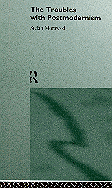
![]()

He acknowledges that postmodernism has merits: it deepens critical awareness; gives new vigour to metaphilosophy; attends to mass culture; refreshes art; reflects on the status of science. But he also views it as a conceptual mess which has abandoned the emancipatory spirit of the avant-garde in favour of obedience to the status quo.
Because of the difficulty of pinning any agreed meaning on postmodernism, he is careful to define what he means, and to look at varying constructions of modernism and the modern subject, and the distinctive properties of postmodernism: the social-cultural; the artistic and the philosophic.
He suggests that the advent of postmodernism signals a period of cultural crisis, in which not only are there no answers, but the ultimate questions have been lost. He looks at recent films to see whether there is an interzone between mass culture and high culture, or the emergence of a new mutation of film. He finds 'pure postmodernist cinema' (p. 44) where everything is an imitation with no trace of ironic distance. He is less sure that pastiche, kitsch and parody have enriched art. He is not against mass art if that is what people enjoy, but sees no reason to turn it into the paragon of culture.
He also asks whether there is a new postmodern aesthetics, but concludes that aesthetics is not rehabilitated by postmodern efforts. 'The wave of aestheticization so praised by a number of sociologists of culture who are dazzled by the social events turned into a spectacle and/or a serial of shop-windows is no salvage of aesthetics. It is mere delusion to see in this superficial carnival of finely packed and quickly purchased goods an aesthetic feast' (p. 65).
He identifies five main troubles with postmodernism. First, postmodernism objects to the totalizing of philosophy, but falls into the trap of making the kind of generalizations it disparages. After the death of the subject, the author's 'I' returns by the back door. Second, it is a false premise that postmodernism is 'post' anything. He argues that modernism 'pondered every premise and assumption, objected to absolute certainty and distrusted both reason and unreason' (p. 98). Postmodernism cannot reduce modernism to a defence of its foundations, since these foundations were always under attack. Third, he objects to the idea of deriving philosophic postmodernism from the heart of art, and especially from the avant-garde. Fourth, he picks out the elitism of the managers and narrow-minded experts of the postmodern period (by which he means the period of mass consumer culture in late capitalism). Finally he questions whether any systematic connection can be traced between totalizing thought and political authoritarianism, citing totalising thinkers who engaged in the defence of liberty. He finds no ethos of responsibility in postmodernism, and so a world without freedom. Cultural pluralism is not the pluralism of responsible, self-conscious subjects, so artists and intellectuals should not abandon moral positions to mass culture.
Morawski insists that postmodernism reduces moral duties to playthings, whereas ethics are part of the history of humankind, and so it is up to the individual to choose their ethics and show how they work. We cannot decide the morality of actions without an ethical code. From this stance he finds postmodernism a largely negative adventure, and disapproves of its dance around the New Idols of victorious consumerism.
Caroline Ramazanoglu
Goldsmiths College, University of London